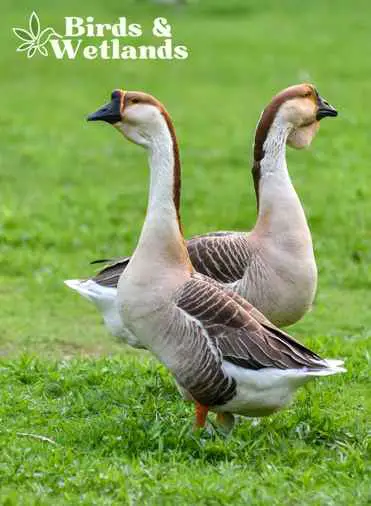Chinese geese are a special breed of goose known for their beauty, grace, and elegance. These geese were on of the first breeds to be domesticated by humans. They are descended from the wild swan goose which they share the same wild color, a brown stripe down the back of the neck, and cream throat.
Chinas are also renowned for their long and graceful necks. These geese also earned the nickname “Swan Geese” because of this trait. The white variety possesses blue eyes, pure white feathers, and orange feet, knobs, and bills.
Besides their striking appearance, Chinese geese also have many practical uses that make them an important part of modern agriculture. They are well-suited for pest control and egg production, making them a valuable asset for any farm or homestead.
Unlike other goose breeds, the Chinese goose belongs to a group known as the knob geese, which have an unusual protrusion on their bill that distinguishes them from other breeds. Today, more than twenty different breeds of Chinese goose can be found around the world.
History of the Chinese Goose in the United States
In 1876, Chinese geese were showcased as “Chinese Swans” at the Centennial International Exhibition in Philadelphia, which was the first official World’s Fair in the United States.
According to his personal records, George Washington kept a few Chinese geese on his Mount Vernon plantation.
Brown Chinese goose and white Chinese geese were both admitted to the American Poultry Association’s Standard of Perfection in 1874.
The Livestock Conservancy, a non-profit organization in the United States, lists it as a watch, its third level of concern.

How Much Is a Chinese Goose Worth?
This goose is a bird commonly bred for ornamental and practical purposes. While the exact price of this goose can vary depending on factors such as gender, age, and temperament, they are typically valued between $20 and $25 for female goslings and between $10 and $15 for male goslings.

Are Chinese Geese Good to Eat?
When choosing a type of goose to eat, there are many factors to consider. Some geese are very fatty, while others are leaner, meaning that the type of meat produced by each bird can hugely impact its culinary value.
The Brown Chinese Goose is generally considered to be one of the best breeds for producing tasty and tender meat. They have very little fat in their meat, making them ideal for those looking for a healthier option. Since their meat is also relatively low in cholesterol, this goose is an excellent choice for anyone looking for quality and nutrition in their meal.

What Is the Difference Between an African Goose and a Chinese Goose?
While the Chinese and African geese are related and share some common characteristics, they differ in several ways. Perhaps most obvious is their appearance — the African goose has a large dewlap and more pronounced knob on the head, while their Chinese counterpart is smaller and lighter.
In addition, African geese tend to be considerably more docile than their Chinese counterparts, making them ideal for commercial meat production and backyard flocks.

Will Chinese Geese Fly Away?
No, they never leave the property despite being free-range and having their wings unclipped.
Why Raise Chinese Geese?
Here are the reasons why Chinas are some of the most popular breeds of domestic goose:
Chinese geese are a popular species of waterfowl known for their adaptable foraging behaviors and moderate size. Because they eat a wide variety of grasses, herbaceous plants, and other flora, they are often used to control unwanted weeds and other plant growth in gardens and lawns. Some poultry catalogs refer to these aggressive foragers as “weeder geese,” highlighting their usefulness as weeders.
Chinese geese are remarkably practical farm animals. They are considered the best layers and are easier to reproduce when mature. The average Chinese goose produces nearly twice as many goslings as other geese. Females lay between 40 and 100 large, white eggs annually if properly managed. Like most waterfowl, older geese produce fewer eggs than young birds.
The Chinese goose’s breeding season typically runs from February to the end of June. Outside of the breeding and chick-rearing seasons, this breed is generally submissive.
These geese are known for their hardy nature, which allows them to thrive in cold weather conditions. Unlike other breeds that tend to hibernate or migrate during cold months, Chinas maintain a relatively consistent level of activity. This is due in part to their thick down feathers, which provide excellent insulation from cold temperatures. In addition, these geese have larger feet and legs than most breeds, which allows them to forage for food even in snow and ice.
It is entirely possible to hand-raise these geese. These small birds are known for their friendly and docile nature and tend to get along well with people if hand-raised and given plenty of care and attention. Additionally, the males (gander) and females of this species tend to be especially easy to raise because they become very accustomed to being handled as they grow up.
Raising these waterfowl is quite easy. Unlike more exotic or elaborate breeds, Chinese geese are relatively affordable and low-maintenance, making them an excellent choice for beginners and experienced chicken keepers. In addition, these birds tend to be quite hardy, meaning they are less likely to suffer from illnesses or diseases than other birds. Another key advantage of Chinese geese is that they do not typically need as much space as other species, making it easy for even a small backyard garden or patch of land to accommodate a healthy flock.
When feeding these waterfowl, choosing a high-quality and nutrient-content diet is important. They feed on grasses, though they may consume other vegetation if they have the opportunity. Some commonly used grasses include timothy, orchardgrass, brome, and bluegrass. Ideally, the grasses should be about 4 inches high to maintain a healthy balance for the geese’s digestive system. Additionally, allowing other animals, like cows or sheep, to graze alongside the waterfowl is a good idea to help keep the grass low and easily digestible.
You can breed these waterfowl pretty early too since they reach sexual maturity and start breeding at around seven months.

Key Points
Chinese geese originated from China, where they were among the first animals to be domesticated.
These geese are known for having compact bodies, pronounced knobs and prominent chests.
They are pretty docile birds and can live with a flock of chickens and ducks.

Jim Addison is an avid bird watcher and has been obsessed with the activity since he was a young boy.
He has traveled all over North America in search of new and interesting species to observe, and his detailed knowledge of the subject makes him a sought-after expert on the topic.

